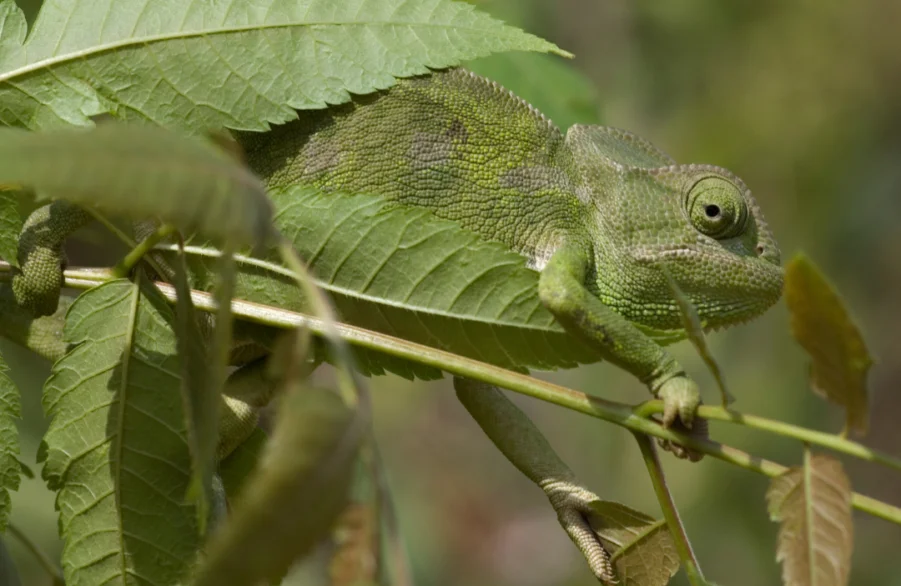On a recent hike in South Georgia, I watched a gorgeous brown butterfly take off from a tree, fly along in front of me, and then disappear. I looked, then looked again, and couldn’t find where it had gone. It looked as though it had evaporated as it passed by a nearby oak. I crept close to investigate, and eventually found the moth totally flattened against the tree. It’s mottled brown coloration was such a perfect match for the tree’s bark, when I looked away it took me a moment to find it away. I had just received a lesson in animal camouflage.
While many animals with defenses like venom and poison use aposematic coloration to advertise themselves, most animals want to lay low. Being stealthy and unseen has its advantages for animals in all parts of the food web. Predatory animals can effectively sneak up on prey, while prey animals can stay off the menu. In this Wildlife Spotlight post, let’s explore some incredible examples of animal camouflage.
1. Swallowtail caterpillars

Although we often recognize butterflies by their bright, gaudy colors, their caterpillars are not always so flashy. In fact, some have truly impressive camouflage. Among my favorites are the larvae of many butterflies in the family Papilionidae, the swallowtails. At certain life stages called instars, between which the larvae molt as they grow, these caterpillars can change dramatically. At their mature stages, they are often handsome green or yellowish, chubby caterpillars.
However, at some intermediate stages, they look like, well, poop. Bird poop, to be exact. These young larvae perfectly mimic the shape, and even the white and black coloration characteristic of bird poo. The result? A disguise that fools most would-be predators, especially birds, and even fascinated naturalists like myself.
2. Bird dropping moths
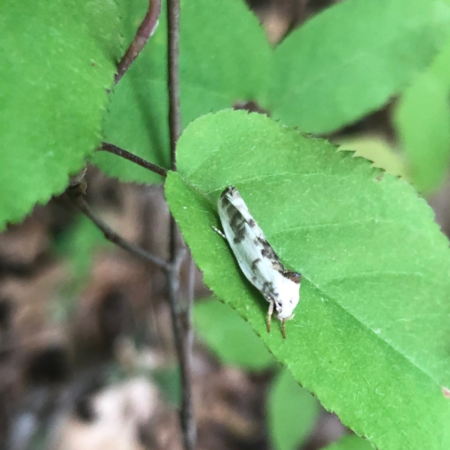
As it turns out, looking like bird poop is a more popular strategy in nature than you might imagine. There are also adult moths that do the same thing. I recently encountered a bird-dropping moth (genus Antaeotricha) by trying to brush it off of my sleeve. I wish I had seen the look on my own face when the bird poo fluttered to a nearby plant and resumed its disguise!
3. Mantids
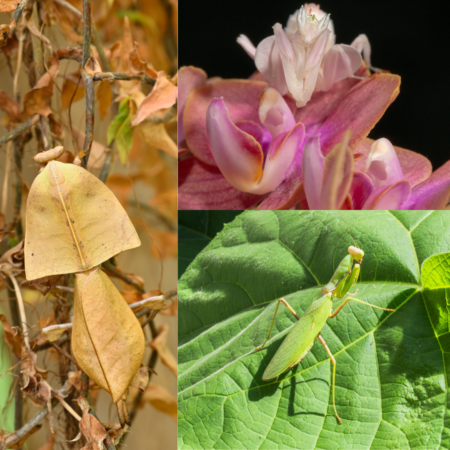
As I mentioned earlier, not all camouflage is for escaping predators. The predatory organisms themselves are also engaged in the art of deception to snatch up unsuspecting prey. Mantids, more popularly known as praying mantises, include some very impressive examples. For instance, the pink orchid mantis (Hymenopus coronatus) of Southeast Asia does a stunning flower impressions. Other mantids look like leaves, dead wood, and more!
4. Crab spiders
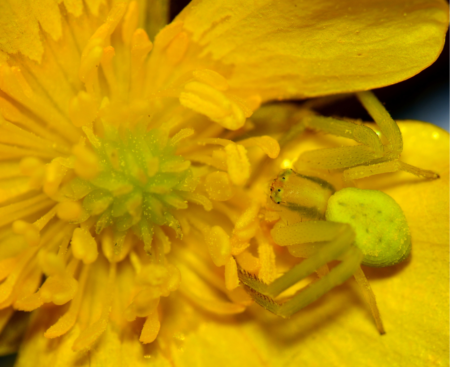
Spiders in the family (Thomisidae) give the pink orchid mantis a run for their money as flower look-a-likes. Many species in this group hide out in feathers to snatch up pollinators rather than building webs. To blend in, they tend to be colored like the flowers in which they wait for prey. Some species may even be able to change color to match their surroundings!
5. Treefrogs

The genus Dryophytes includes a bunch of neat tree-frogs with interesting songs and, you guessed it, tree-dwelling habits. To stay safe in the trees, many North American species have developed coloration that is incredibly similar to the lichens growing on tree bark. The result? A fantastic disguise that keeps them out of sight from many would-be predators.
Two fantastic examples in the Eastern U.S. are the Gray treefrog (Dryophytes versicolor) and the Cope’s gray treefrog (Dryophytes chrysoscelis) further South. If I had a nickel for every time I could hear one of these beauties singing inches away and couldn’t find it! Nearly every time I have found one of these beauties it’s been a lucky accident. They are really top-botch hide-and-seek pros.
6. Nymphister kronaueri, the “ant-butt beetle”
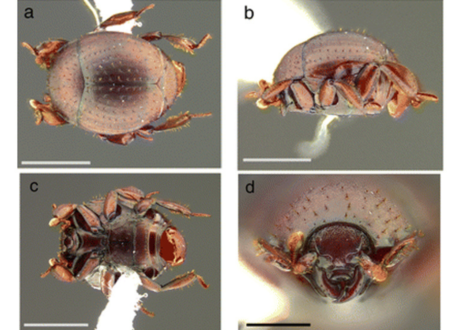
Do you need a totally bizarre nature fact for your next cocktail party? Look no further, friend. This example of wacky animal camouflage continues to rock my world. Researchers recently discovered a beetle species, Nymphister kronaueri, that has a baffling disguise strategy. It’s rotund body mimics the micro-structures of the abdomens (butts) of army ants in tropical America. More than that, the beetle finds marching army ants and clamps onto their waists, effectively mimicking their derrieres.
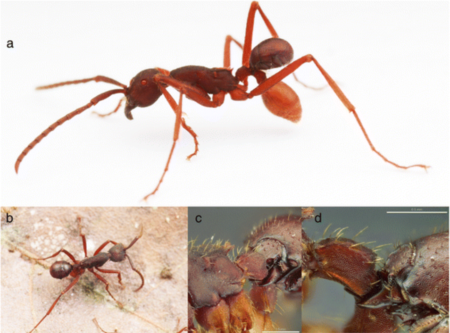
By feeling, and presumably also smelling, like an ant-butt, the beetle goes undetected by the rest of the colony. It gets a free ride to wherever the army is headed, and presumably can find food that way as well. You’ve got to give Nymphister points for originality.
7. Octopi
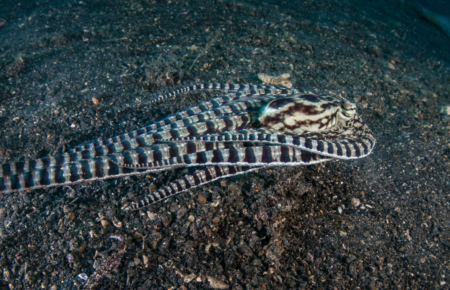
While most experts at animal camouflage have a specialty costume, some are also versatile. Octopi (order Octopoda) are notoriously good imitators, because of their ability to change color and take on diverse shapes. One species in particular takes this to another level: the mimic octopus (Thaumoctopus mimicus).
These gorgeous mollusks of tropical Asian oceans not only adjust their colors and the textures of their bodies, but also their behavior. In other words, they’re great actors. They will deliberately mimic the ways that other ocean animals move to confuse potential predators. Mimic octopi even engage in aposematic displays by pretending to be deadly sea snakes!
8. The Lichen grasshopper and other Orthopterans
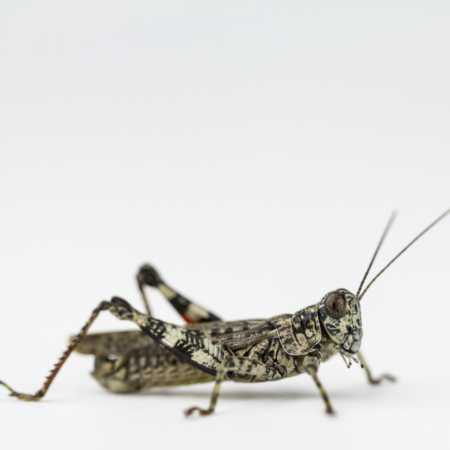
I first met Trimerotropis saxatilis while visiting a granite outcrop in North Georgia. I found these incredible grasshoppers hiding amongst the lichen-crusted granite boulders. They were nearly invisible until they moved, and I never managed to get a decent photograph. These amazing invertebrates were obviously taking a page from the treefrog’s book, or vice versa! Everything from the off-gray-green color to their mottling of black is a perfect fit for their environment.
Many insects in the order Orthoptera are excellent mimics. For example, bush crickets or katydids (family Tettigoniidae) often resemble leaves or other green parts of plants to an impressive degree.
9. Vine snake

The Sri Lankan green vine snake (Ahaetulla nasuta) is a truly impressive example of reptilian animal camouflage. These long, thin snakes imitate the color and shape of the common vibes in their tropical forest habitats. By moving slowly and even swaying like vines in the breeze, they keep safe from snake-hungry predators like hawks. At the same time, they can also more easily sneak up on the frogs and lizards that make up their diet.
The vine snake’s elongated head and pointed snout are particularly impressive parts of its disguise. While snakes are naturally pretty vine-like, the broader heads of venomous snakes can give them away. The vine snake doesn’t have this problem!
10. Golden plovers
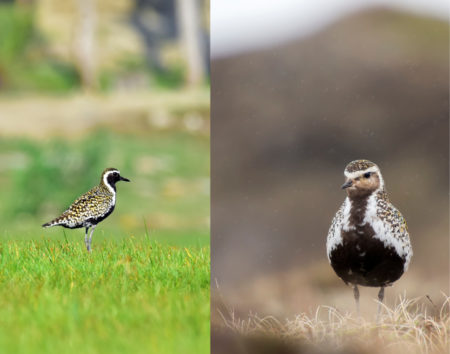
Most people think of plovers as near, beach-dwelling birds commonly encountered along the seashore. However, for some plovers, these habitats are just rest-stops during the non-breeding season. The Golden plovers (genus Pluvialis) fall into this category. Specifically, species in this genus breed up in the high arctic tundra, migrating down to warmer coastal climates during Winter.
Looking at an adult Golden plover, you might not be very impressed by their camouflage. However, it’s their babies that have the real stealth skills. There are few places to hide out on the open tundra, so young Golden plovers resemble the mosses that cover the ground. Since these chicks are otherwise defenseless prey for Arctic foxes and other predators, hiding is the best strategy!
11. Glass frogs
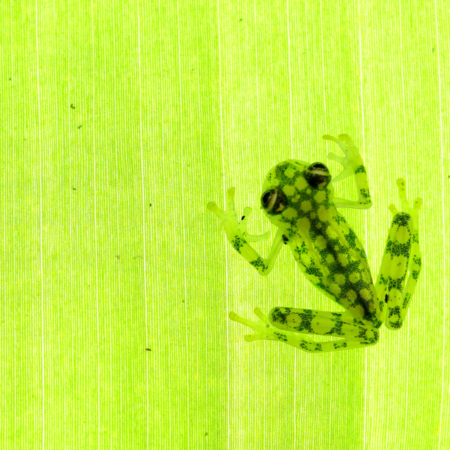
Of course, the ultimate animal camouflage superpower would be total invisibility. It worked pretty well for the alien villain in Arnold Schwarzenegger’s Predator and the Klingons in Star Trek, after all. While total invisibility isn’t necessarily on the table for wildlife on our planet, some amphibians are definitely going for it.
The glass frogs (family Centrolenidae) have largely transparent skin and musculature, making them blend in closely with their surroundings. These tropical tree-dwellers can better match the many shades of green in their environment by being mostly transparent. Creepily enough, this also means that you can see their internal organs in the right light. Yikes!
Thanks for reading!
Have you found exciting examples of animal camouflage in your area? Share with us in the comments! Please help Gulo in Nature grow by sharing this post with a friend or connecting with us on Social Media. Until next time!

